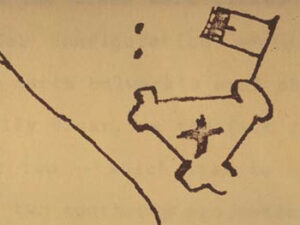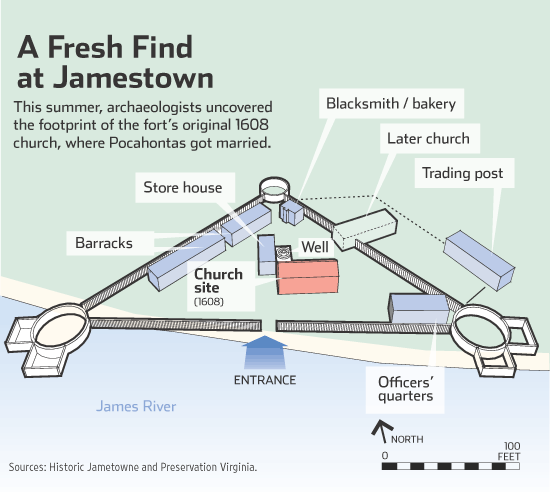The Wall Street Journal, Saturday, October 23, 2010
Her life has been celebrated in song, story and a Disney cartoon, but no one knew where Pocahontas tied the knot with a tobacco farmer—until now.
Archaeologist Bill Kelso and his team were digging this summer in a previously unexplored section of the fort at Jamestown, Va., the country’s oldest permanent English colony, when they uncovered a series of deep holes. They believe the holes once anchored heavy, timber columns supporting the fort’s first church, known to have been built in 1608 and the place where Pocahontas got married in 1614.
The 60-foot-long walls and thatch roof are all gone now, but a row of graves was subsequently found in what would have been the church’s chancel— an area near the altar where prominent Anglicans were traditionally buried. “That’s when we started high-fiving,” said, Mr. Kelso, director of archaeology at Historic Jamestowne, a nonprofit organization that oversees excavations there. “I’m convinced we’ve found the church.”
The church’s exact location had bedeviled Jamestown scholars for years. Records say it was built roughly a year after Britain’s King James sent a crew of around 100 men, including Captain John Smith, to establish an outpost 40 miles upriver from the mouth of the Chesapeake Bay.
The men were supposed to be primarily seeking a profit, not Christian converts. The only previous evidence of a church consisted of remnants of a later church, built in 1617 near the eastern wall of the fort. But this summer’s find proves Capt. Smith’s men planted their first church in the center of the compound, the first and largest structure anyone would notice after passing through the fort’s entrance.
“People have never associated Jamestown with religion, but it was positioned to make a statement,” said James Horn, vice president of research and historical interpretation at Colonial Williamsburg, which helps manage the fort site.

A drawing of James Fort (ca. 1608) by Pedro de Zuniga, the Spanish
ambassador to London at the time. The sketch shows a flag-like projection, which is more probably an enclosed garden. The three sides and circular bastions at the corners are common to all three known descriptions of the early fort.
Pocahontas, a powerful chief’s daughter, became acquainted with Captain Smith and the other colonists in 1607 and, Smith claimed, saved his life after he’d been taken prisoner by her father’s men. Smith returned to England in 1609 and Pocahontas married settler John Rolfe; three years later, she died in England.
Next spring, forensic anthropologists will exhume the row of chancel graves, which might contain the remains of the fort’s first minister or Sir Ferdinando Wenman, a knight who arrived in 1610 to rally the fort’s starving few and aid the colony’s historic turnaround.


